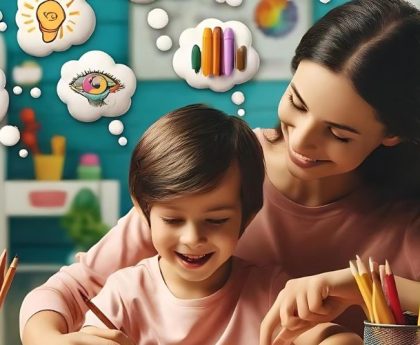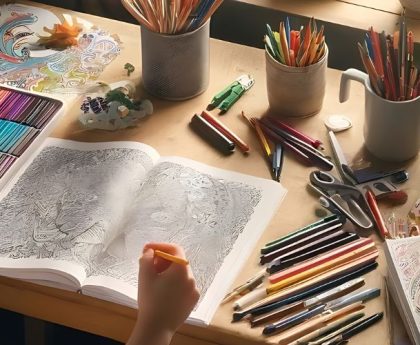Coloring books have been a staple in childhood for generations, providing hours of entertainment and a creative outlet for young minds. Beyond their obvious entertainment value, coloring books offer a wealth of educational benefits that contribute to a child’s cognitive, emotional, and physical development. This article explores the numerous ways in which coloring books can be educational tools, helping children learn and grow in various areas.
Cognitive Development
Coloring books play a significant role in the cognitive development of children. They help improve concentration, enhance understanding of concepts, and stimulate intellectual growth.
Enhancing Focus and Concentration
Coloring requires a child to focus on completing a task, which can significantly improve their attention span and concentration. When children sit down with a coloring book, they must concentrate on staying within the lines, choosing appropriate colors, and completing the picture. This sustained focus helps develop their ability to concentrate on other tasks as well, both academic and non-academic.
Learning Colors, Shapes, and Patterns
Coloring books are an excellent tool for teaching children about colors, shapes, and patterns. Through coloring, children learn to identify and differentiate between various colors and shapes. They also begin to understand patterns and symmetry, which are fundamental concepts in mathematics and art.
Activities:
- Color Recognition: Provide coloring books with pictures that require the use of specific colors. Ask children to color objects correctly, such as apples in red, leaves in green, etc.
- Shape Identification: Use coloring books that emphasize different shapes and ask children to identify and color specific shapes.
- Pattern Recognition: Encourage children to create or follow patterns within their coloring pages, enhancing their understanding of sequences and repetition.
Enhancing Memory and Spatial Awareness
Coloring helps improve a child’s memory and spatial awareness. Remembering which colors to use and where to apply them aids memory development. Additionally, understanding spatial relationships within a coloring page—such as the proximity of different objects to one another—enhances spatial awareness.
Activities:
- Memory Exercises: Show a child a colored picture and then provide a blank version for them to replicate from memory.
- Spatial Games: Use coloring books with scenes that require children to think about spatial relationships, such as navigating a maze or placing animals in a habitat.
Emotional and Psychological Benefits
Coloring books are not just beneficial for cognitive development; they also have significant emotional and psychological benefits. They can help children manage emotions, express themselves, and build confidence.
Emotional Expression and Regulation
Coloring provides a non-verbal outlet for children to express their emotions. Through the use of colors and creative designs, children can convey their feelings and moods. This can be particularly helpful for children who struggle with verbal communication.
Activities:
- Mood Coloring: Provide children with coloring pages and ask them to choose colors based on how they feel. Discuss their color choices and emotions afterward.
- Emotion-Themed Coloring Books: Use coloring books that focus on emotions, such as happy, sad, or angry faces, to help children understand and express their feelings.
Stress Relief and Relaxation
Coloring is a calming activity that can help reduce stress and anxiety in children. The repetitive motion of coloring within the lines can be meditative, allowing children to relax and focus on the present moment.
Activities:
- Calming Coloring Sessions: Set aside quiet time for coloring, creating a peaceful environment with soft music and minimal distractions.
- Mindfulness Coloring: Encourage children to focus on their breathing and the sensation of coloring, promoting mindfulness and relaxation.
Building Confidence and Self-Esteem
Completing a coloring page gives children a sense of accomplishment and boosts their self-esteem. It provides tangible evidence of their effort and creativity, which can be a great confidence booster.
Activities:
- Celebrating Completion: Display finished coloring pages on the wall or in a special folder to celebrate the child’s accomplishments.
- Encouragement and Praise: Offer positive reinforcement and praise for their work, focusing on effort and creativity rather than perfection.
Physical Development
Coloring books also contribute to physical development by improving fine motor skills and hand-eye coordination.
Fine Motor Skills
Coloring requires precise movements, which help develop fine motor skills. These skills are essential for many activities, such as writing, tying shoelaces, and using utensils.
Activities:
- Detailed Coloring Pages: Provide coloring books with detailed images that require careful coloring.
- Different Coloring Tools: Encourage the use of various coloring tools like crayons, colored pencils, and markers to develop different grips and movements.
Hand-Eye Coordination
Coloring helps children develop hand-eye coordination by requiring them to color within the lines.
Activities:
- Tracing and Coloring: Use coloring books that include tracing activities, helping children improve their coordination by following lines before coloring.
- Dot-to-Dot Pages: Incorporate dot-to-dot coloring pages that require children to connect dots before coloring, further enhancing hand-eye coordination.
Integrating Learning with Coloring
Coloring books can be used to teach a wide range of subjects, from math and science to language arts and social studies.
Alphabet and Number Recognition
Coloring books can help young children learn to recognize letters and numbers. Many coloring books are designed with educational themes that incorporate the alphabet and numbers into the pictures.
Activities:
- Alphabet Coloring Books: Use books that feature a letter on each page, along with corresponding images (e.g., A for Apple, B for Ball). Encourage children to say the letter and word aloud as they color.
- Number Coloring Books: Provide books that focus on numbers, with images that include the number of objects matching the numeral on the page.
Learning About Animals, Plants, and the Environment
Coloring books can introduce children to the natural world, teaching them about different animals, plants, and ecosystems.
Activities:
- Animal Coloring Books: Use books that feature various animals and their habitats. Discuss the animals and their characteristics as the child colors.
- Plant and Flower Coloring Books: Provide books that focus on different types of plants and flowers. Talk about the parts of a plant and their functions while coloring.
Cultural and Historical Education
Coloring books can also be educational tools for teaching children about different cultures, historical events, and famous people.
Activities:
- Cultural Coloring Books: Use coloring books that depict cultural festivals, traditional clothing, and landmarks from around the world. Discuss the significance of these images as the child colors.
- Historical Figures Coloring Books: Provide books that feature historical figures and events. Share stories about these figures and their contributions to history.
Conclusion
Coloring books are more than just a fun activity; they are powerful educational tools that can aid in the development of cognitive, emotional, and physical skills. By integrating learning into coloring, parents and educators can create engaging and educational experiences for children. Whether through improving focus and concentration, fostering emotional expression, or enhancing fine motor skills, coloring books offer a wide range of benefits that support a child’s overall growth and development. So, the next time you hand a coloring book to a child, know that you are giving them much more than just a way to pass the time—you are providing them with opportunities to learn, grow, and express themselves creatively.
Additional Resources
Colouring books we have created.
We hope you find this article interesting. Please note that we are not offering this information as qualified medical advice and we would always recommend that you seek guidance from a trained and qualified professional where appropriate.





